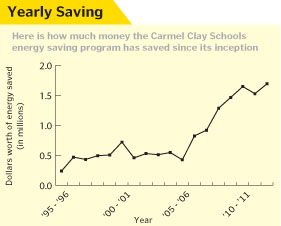 Saving $14,709,780 is no small feat. Yet, Robert Yull, Energy Manager of the Carmel Clay Schools District, managed to help Carmel Clay Schools not only avoid that cost in the schools’ energy usage but also help the environment as well.
Saving $14,709,780 is no small feat. Yet, Robert Yull, Energy Manager of the Carmel Clay Schools District, managed to help Carmel Clay Schools not only avoid that cost in the schools’ energy usage but also help the environment as well.
The energy savings program, which began in July 1995, has allowed Carmel Clay Schools to stay environmentally friendly while cutting back on energy costs. The myriad of ways the program has saved energy ranges from planting flowers and grasses to recycling batteries and computers and from reducing pesticide usage to controlling water temperatures.
Yull said, “We tried to have a program to have the staff turn the lights off in unoccupied areas. We tried to look at the times we need to save air conditioning and heating. We’ve done some things like motion detectors and devices like that to lower energy.”
The program has also monitored electricity usage.
“When you burn coal, you emit all kinds of impurities into the air. I’m sure the coal companies try to minimize that as much as they can, but there still are going to be excess amounts of CO2,” Rushing said. “There may be some sulfur oxides, there may be nitrogen oxides that are released into the atmosphere that will all be considered pollutants, so if we can cut down on the amount of that, then that’s a good thing.”
Charles Liang, president of the Environmental Club and senior, said he feels the energy conservation program has done a great job in conserving energy and saving money.
“The energy conservation program has been really good because the school can use the saved money for other purposes. The school is demonstrating that it is being a leader in going green in the community,” Liang said. “Saving energy is really important because most of this energy right now is currently coming from nonrenewable energy sources like coal, which is the primary source of energy in Indiana, so by conserving energy, we’re also conserving resources, and we’re also helping the environment by preventing the adverse effects of nonrenewable energy.”
Students at CHS also contributed to the energy saving program. Members of the CHS Green Team, which now comprises the Sustainable Living Club and the Environmental Club, have been working on a project to install eight motion sensor lights in eight CHS restrooms. According to Liang, the project will prevent about three tons of carbon dioxide emissions annually.
Liang said he hopes that these projects will raise student awareness about being environmentally friendly.
“Through these green projects like the light motion sensor project, these cool acts of green can help raise awareness about the importance of going green and inspire people to further their green efforts,” he said.
There are many ways by which students can continue to protect the environment, including recycling, using both sides of papers and reminding teachers to turn off lights when classrooms are unoccupied.
“People often think that what they do, like the little things, doesn’t really matter, but if every person saves a little, all the little things add up,” Liang said, “Together, we can make a huge positive, collective difference.”

































![AI in films like "The Brutalist" is convenient, but shouldn’t take priority [opinion]](https://hilite.org/wp-content/uploads/2025/02/catherine-cover-1200x471.jpg)








































![Review: “The Immortal Soul Salvage Yard:” A criminally underrated poetry collection [MUSE]](https://hilite.org/wp-content/uploads/2025/03/71cju6TvqmL._AC_UF10001000_QL80_.jpg)
![Review: "Dog Man" is Unapologetically Chaotic [MUSE]](https://hilite.org/wp-content/uploads/2025/03/dogman-1200x700.jpg)
![Review: "Ne Zha 2": The WeChat family reunion I didn’t know I needed [MUSE]](https://hilite.org/wp-content/uploads/2025/03/unnamed-4.png)
![Review in Print: Maripaz Villar brings a delightfully unique style to the world of WEBTOON [MUSE]](https://hilite.org/wp-content/uploads/2023/12/maripazcover-1200x960.jpg)
![Review: “The Sword of Kaigen” is a masterpiece [MUSE]](https://hilite.org/wp-content/uploads/2023/11/Screenshot-2023-11-26-201051.png)
![Review: Gateron Oil Kings, great linear switches, okay price [MUSE]](https://hilite.org/wp-content/uploads/2023/11/Screenshot-2023-11-26-200553.png)
![Review: “A Haunting in Venice” is a significant improvement from other Agatha Christie adaptations [MUSE]](https://hilite.org/wp-content/uploads/2023/11/e7ee2938a6d422669771bce6d8088521.jpg)
![Review: A Thanksgiving story from elementary school, still just as interesting [MUSE]](https://hilite.org/wp-content/uploads/2023/11/Screenshot-2023-11-26-195514-987x1200.png)
![Review: "When I Fly Towards You", cute, uplifting youth drama [MUSE]](https://hilite.org/wp-content/uploads/2023/09/When-I-Fly-Towards-You-Chinese-drama.png)
![Postcards from Muse: Hawaii Travel Diary [MUSE]](https://hilite.org/wp-content/uploads/2023/09/My-project-1-1200x1200.jpg)
![Review: "Ladybug & Cat Noir: The Movie," departure from original show [MUSE]](https://hilite.org/wp-content/uploads/2023/09/Ladybug__Cat_Noir_-_The_Movie_poster.jpg)
![Review in Print: "Hidden Love" is the cute, uplifting drama everyone needs [MUSE]](https://hilite.org/wp-content/uploads/2023/09/hiddenlovecover-e1693597208225-1030x1200.png)
![Review in Print: "Heartstopper" is the heartwarming queer romance we all need [MUSE]](https://hilite.org/wp-content/uploads/2023/08/museheartstoppercover-1200x654.png)




